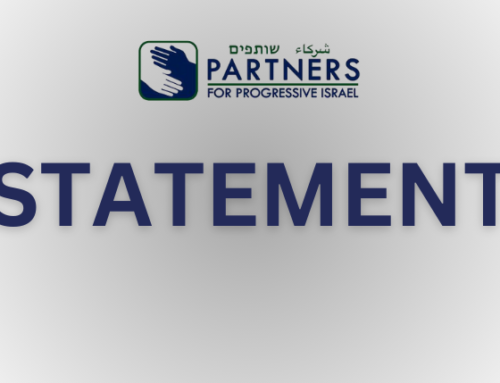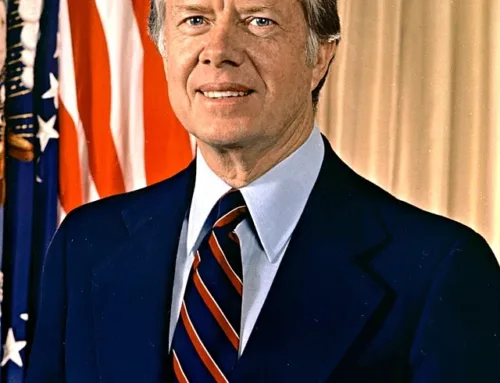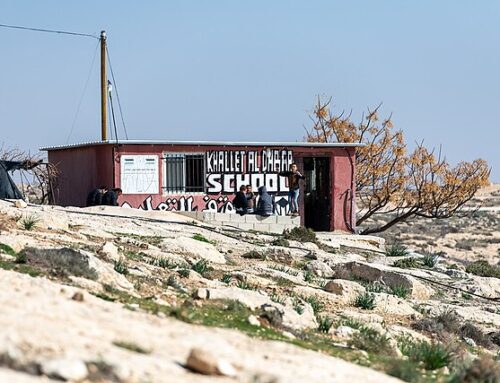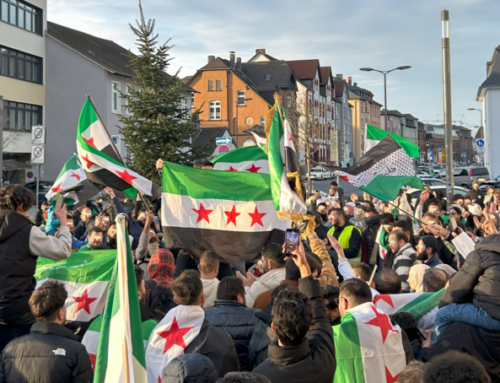 |
| This is my second post as PPI’s asst. dir. |
On the fourth day of the Partners for Progressive Israel’s “Israel Symposium,” our group traveled from Tel Aviv to Ramallah, where we met with Dr. Mohammad Shtayyeh, the Minister in charge of the Palestinian Economic Council for Development and Reconstruction (PECDAR), and negotiator (alongside Saeb Erekat) to the talks with Israel. Our group sat around a large oval table in a conference room of the PECDAR building in Ramallah. As we drank juice, Shtayyeh discussed the time pressure Israelis and Palestinians face to reach a two-state solution.
 |
|
Dr. Mohammad Shtayyeh | Photo: Lisa Goldman
|
He spoke about the unprecedented effort of Secretary of State John Kerry to bring both parties to negotiations, and he defined in specific terms what justice would look like for him. He stated four points that must happen to bring justice to the Palestinians: a Palestinian state must exist in the West Bank, with the green line as its border (and agreed land swaps, if necessary); Jerusalem must, once again, be an open city, with East Jerusalem the capital of Palestine; refugees must be resettled, in agreement with Israel; and there must be no limitations on Palestinian dignity, sovereignty or independence.
Dr. Shtayyeh’s definition of justice was the first I had heard that did not involve punishing Israel for the Nakba, the Naksa or the violence of its history. Instead, Shtayyeh addressed Palestinian injustice in a way that delivered the most benefit to Palestinians and demanded no blood from Israel. His concept of justice was practical; he did not call for a return of all Palestinian refugees and their descendants to Israel proper, and said it is unreasonable to assume all of them would want to leave their current homes. Moreover, his justice focused on the only way to mend the history of Palestinian deprivation: a Palestinian state not at war with any other state or people.
Dr. Shtayyeh’s view of justice relies on changing future events by breaking the cycle of violence that propels the Israeli – Palestinian conflict deeper into intractability. He does not want to negotiate the history of the conflict, or national narratives, or who is to blame. Instead, he wants to discuss the changes that need to happen so that the Palestinians can begin to overcome their national trauma and build a nation-state.
Dr. Shtayyeh’s comments were refreshing. As a Jewish Zionist, I believe in ending the occupation and resolving the conflict with the Palestinians through negotiations and multi-track diplomacy. But, as centered and fair as I think my concept of justice is, it is up to the Palestinians to define what justice is for their people; how the conflict beyond the occupation can end forever. Shtayyeh’s concept of justice dissolved my concern because it stated clearly that justice for Palestine cannot be the eternal punishment of Israel, and cannot result in Israel’s demise. In an ethno-national conflict, belonging to one side often comes to mean rejecting the other. But Shtayyeh, like other visionaries of peace before him, approached the conflict from a higher perspective that regards national self-determination as justice, and justice as a means to end conflict, violence and rejection.
 |
|
Amira Hass | Photo: Francesco Alesi
|
Immediately after our meeting with Mohammad Shtayyeh, we went to lunch at a Ramallah restaurant with Haaretz journalist Amira Hass. Whereas Shtayyeh spoke about major shifts in the relationship between Israel and the Palestinian Authority—and how those shifts can deliver justice to Palestinians without unreasonable cost to Israelis—Amira Hass spoke about the true depth of Israeli intransigence on one side, and Palestinian disillusionment on the other. Hass is an Israeli Jew living in Ramallah, which gives her a rare and important perspective on the conflict. She explained, over bits of pita and hummus, that the disgust Israelis need to feel about the occupation, which is the only real force that can effect change, is nonexistent. She blames Israeli complacency for expanding settlements, all of which is a clear example of the ease with which Israel rejects Palestinian nationalism.
This form of rejection, in all its banality, compounds the Palestinians’ frustration, and any Palestinian reaction that makes Israel feel that frustration further entrenches Israelis in their opposition to Palestinian statehood. (I do not count terrorism as a legitimate means to express that frustration). At the same time, in the West Bank, Palestinians often see the P.A. as an incapable government. The Oslo agreement led to more settlements and to less Palestinian autonomy. In this regard, Hass explains, Palestinians have very little faith that Shtayyeh, for all his good intentions, can get anything done.
Our group was frustrated with Hass’s analysis, especially as it came immediately following Mohammad Shtayyeh’s uplifting discussion. In spite of the deflating effect, however, listening to Hass tear down much of what Shtayyeh said was important for the nuance it added to our understanding of the situation.
To understand fully what Amira Hass was telling us, I looked to young, educated Palestinian perspectives. One of these, Linah Alsaafin, lives in the West Bank and writes for the Electronic Intifada blog. She writes often about “the part of Palestine that Zionist forces seized in 1948,” referring to Israel proper. This may sound like the perspective of an extreme fringe of West Bank Palestinian society because it rejects Israel’s right to exist, as well as any legitimacy in Zionism. But this view has become more mainstream as the occupation expands. Twenty years ago, Edward Said, writing in the London Review of Books, spoke out against the Oslo agreement. Oslo, Said wrote, was “an instrument of Palestinian surrender, a Palestinian Versailles.” The PLO leadership had sold out, jumping at an agreement that did nothing to solve the national trauma of the Nakba. Twenty years after Oslo, Said’s voice has become Linah Alsaafin’s. Her view is the development of the very problems that Edward Said wrote were unaddressed by the Olso Accords. And Amira Hass translates it into Hebrew.
After these two meetings, our group was left with two seemingly competing perspectives on the conflict: Mohammad Shtayyeh’s constructive view of the future, and Amira Hass’s rational, discouraged view of the present. These views, however, are not in opposition. Amira Hass told us about the Palestinian belief in a two-state solution dissolving as the occupation becomes stronger. Reading voices like Edward Said’s and Linah Alsaafin’s, and shedding light on the progression of those views, reveals the legitimacy of Palestinian frustration.
This view, when paired with Mohammad Shtayyeh’s, creates a fuller understanding of the situation. Just as national self-determination was the answer to Jewish suffering, so too is Palestinian statehood the answer to Palestinian suffering. This may sound like a simplistic message to walk away with, but with this new understanding, certain themes crystallize. One of those themes is the justice that self-determination brings to a nation. Just as Zionism did justice for Jewish suffering without punishing the world that abused us, Palestinian nationalism can bring justice to Palestinian suffering without punishing Israel. On the other hand, just as Israeli rejection of Palestinian nationalism pushes rational Palestinians away from a solution, Palestinian rejection of Zionism also works toward more entrenched conflict. Rejection, as a theme, deepens conflict.
People like Mohammad Shtayyeh are remarkable because they define and apply these themes. Shtayyeh promotes these ideas not in spite of the national desperation of the Palestinians, but in response to it; a nation-state will bring justice to the Palestinians. The problem is that the status quo of the conflict—continued Israeli military control coupled with expanding Jewish settlements in the West Bank—is redefining the playing field. Thoughtful voices like Edward Said’s have become radical positions like Linah Alsaafin’s because the peace process has not yet changed the situation; Palestinian statehood seems to be even further away than it was in the early 1990s. Our group heard from the Palestinian side of negotiations with Shtayyeh’s solution-based approach, and we heard a realistic report on a different Palestinian perspective from Amria Hass.
The contrast of these voices left the problem in stark relief: the status quo promotes Israeli rejection of Palestinian nationalism, rejection radicalizes, and radicalism is violent. It also clarified the solution: justice is self-determination, self-determination means a Palestinian state in the West Bank, and a Palestinian state is a means to end Palestinian frustration, radicalism and violence. Dr. Shtayyeh is dedicated to bringing that justice to his people, but recently chose to resign from negotiations rather than see the status quo kill them. I think we should push our leaders to take advantage of his willingness to negotiate, and bring about the justice of an Israel living, finally, in peace.









Dear Nathan,
I think this is a confusing piece.
How will Palestinians achieve “justice” through self-determination if roughly 4.5 million are consigned to disconnected bantustans on less than 22% of the land, while 7.9 million Israelis control more than 78% of the land, and control most strategic resources?
Furthermore how will justice be achieved if 5 million Palestinian refugees and their descendants are consigned to having only the option of returning to those deprived bantustans, while any Jew from anywhere in the world who never lived there can “return” and become an Israeli citizen in a country with greater land, resources and possibilities?
In short does your understanding of justice through self-determination include any conception of equity?
Do you understand that self-determination and the realization of human rights do require a state specific to the ethnicity, religion or other particular status of each individual?
I know you’d like to cling to Mohammed Shtayyeh’s vision, and cite him as your reference because he’s a Palestinian and his vision is convenient for you, but he’s a product of the 90’s whose time has passed. He represents an unelected government (and even that unelected government recognizes that its term has passed), and the last elections that were held anyway represented only a minority of the Palestinian people.
You would be wiser to try to deal with the realities presented by Lina AlSaafin and Amira Hass who are more in touch with the people than Shtayyeh is from his bubble.
Good luck,
Ted
If Mohammed Shtayyeh is “a product of the 90’s,” Ted’s thinking is a product of the ’40s and ’50s. “Justice” for both Israelis and Palestinians, Jews and Arabs, is not a simple proposition; it is not “just” to deprive Israelis of their hard-won independence. Still, I understand that many in Meretz advocate a limited “right of return” for Jews, which would only involve those needing refuge from oppression.
Similarly, a Palestinian right of return must be limited to its new state. But a humane solution for the 1948 refugees and their progeny must involve a range of options and choices for normalization, resettlement and compensation, as envisioned in the Geneva Accord model.
As much as Ted might wish, history cannot be erased. Although some Zionists advocated a bi-national shared state of Palestine, the Arab side overwhelmingly rejected this vision. Tragically, the Arab side also rejected the United Nations partition plan of 1947; it was because of their violent rejection of partition, expressed in the Palestinian and allied Arab effort to destroy what became Israel in 1948-49, that the refugee problem emerged. Moderates are struggling to return to a version of partition now, but nationalist passions on both sides and the lack of mutual trust make this solution difficult. Ted’s absolutist and one-sided notion of “justice” only leads to more conflict and tragedy for all concerned.
The paragon of unndestandirg these issues is right here!